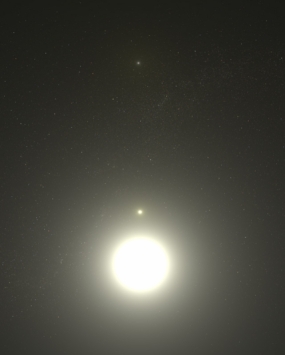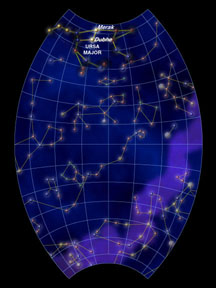Artist's concept of the Polaris triple star system
Click on image for star map
NASA, ESA, G. Bacon (STScI)
Polaris - the North Star
|
What's in a Name: |
So named because it is the closest star to the celestial north pole.
|
|
Claim to Fame:
|
It's the famous North Star! (actually a triple star system) |
| Type of Star: |
Yellow-white Supergiant |
|
How Far Away: |
430 light years away |
|
How Big: |
About 46 times the size of the Sun |
| How Bright: |
Roughly 1800 times the luminosity of the Sun |
|
Where to View: | In the constellation Ursa Minor.
|
|
When to View: | All year round in the Northern Hemisphere |
You might also be interested in:

How did life evolve on Earth? The answer to this question can help us understand our past and prepare for our future. Although evolution provides credible and reliable answers, polls show that many people turn away from science, seeking other explanations with which they are more comfortable.
...more
Scientists using a new telescope found the size of the North Star, also known as Polaris. It turns out that Polaris is 46 times larger than the Sun. It is no surprise to scientists, because Polaris is
...more
Something new and exciting is happening at Windows to the Universe! Windows scientists say they discovered twelve new stars, including one that is the second brightest in the night sky! They decided to
...more









